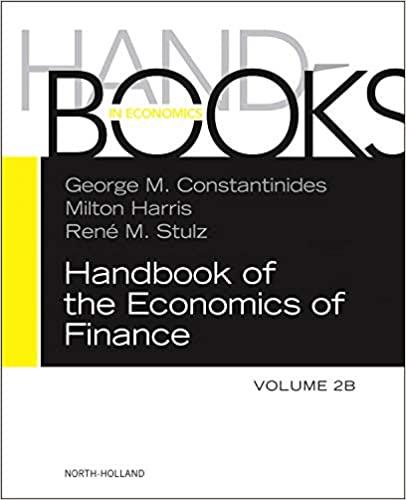Question
Calculate the intrinsic value of the company by conducting a two-stage DCF company-level valuation analysis, Compare your results to the current market capitalization of the
Calculate the intrinsic value of the company by conducting a two-stage DCF company-level valuation analysis, Compare your results to the current market capitalization of the company and Perform a sensitivity analysis. The requirements of the assignment are as follows: 1. Calculate the Intrinsic Value of Your Company: You will use the two-stage company-level Discounted Cash Flow (DCF) valuation model to calculate the intrinsic value of your chosen company. a. Calculate the Free Cash Flow based on most recent fiscal year data: Estimate the free cash flows (FCF) available to the firm. To do this you can use the below formula: FCF = Cash Flow from Operations - Capital Expenditures + Interest * (1 - Tax Rate) The "Cash Flow from Operations" and "Capital Expenditures" can be found on the Statement of Cash Flows in Yahoo! Finance. The Interest expense (if any exists) is on the Income Statement. The Tax Rate can be calculated based on the Tax Expense and Net income (as was performed in the first course project). For additional details on these calculations please refer to this external resource. b. Specify the WACC For the discount value you should use the weighted average cost of capital (WACC). You can either use the value you calculated from the prior course project assignment or you can use the value generated by the website www.thatswacc.com. c. Conduct a two-stage valuation You can now combine the two items above to estimate a present value of the firm. You should calculate a high-growth phase value and a terminal value. 1. High Growth Phase Value: For this phase, assume that in years 1 - 3 the Free Cash Flows are growing by 8% annually. 2. Terminal Value: For this phase assume the FCF grow at a constant growth rate of 2.5%. Calculate the present values of the above phases and add them together for the total present value of the company. 2. Comparison to Current Market Capitalization: a. On the Key Statistics page in Yahoo! Finance identify and indicate the Market Capitalization ("market cap"). What does this value represent? b. Compare the market cap to your calculated value. To compare the market cap from Yahoo! Finance to the firm value you calculated in the previous section above you need to first subtract the value of the debt from your firm value calculation. How does your intrinsic value (less debt) compare to the market cap of the company on Yahoo! Finance? What might account for any differences between these two values? 3. Conduct a Sensitivity Analysis: a. Vary the following inputs to the two-tier valuation model and indicate the new valuation amount and the percentage change from the above "base" case. Free Cash Flows 0. Increase the FCF by 10% 1. Decrease the FCF by 10% Terminal Growth Rate 0. Increase the Terminal Growth Rate from 2.5% to 3.5% 1. Decrease the Terminal Growth Rate from 2.5% to 1.5% WACC 0. Add 2% to the WACC (that is if the WACC is 7.5% make it 9.5%) 1. Subtract 2% from the WACC (that is if the WACC is 7.5% make it 5.5%) b. Observations State your observations from the sensitivity analysis. How important (conceptually) is the terminal growth rate to overall value? How important is the WACC to overall value?
Bank of America Cash flow https://finance.yahoo.com/quote/BAC/financials?p=BAC
Cash Flow
All numbers in thousands
| Period Ending | 12/31/2016 | 12/31/2015 | 12/31/2014 |
| Net Income | 17,906,000 | 15,836,000 | 5,520,000 |
| Operating Activities, Cash Flows Provided By or Used In | |||
| Depreciation | 5,375,000 | 5,002,000 | 4,221,000 |
| Adjustments To Net Income | 7,603,000 | 3,802,000 | 1,189,000 |
| Changes In Accounts Receivables | - | - | - |
| Changes In Liabilities | -35,000 | 730,000 | 9,702,000 |
| Changes In Inventories | - | - | - |
| Changes In Other Operating Activities | -12,543,000 | 427,000 | 4,297,000 |
| Total Cash Flow From Operating Activities | 18,306,000 | 28,347,000 | 30,795,000 |
| Investing Activities, Cash Flows Provided By or Used In | |||
| Capital Expenditures | - | - | - |
| Investments | -62,951,000 | -55,532,000 | -5,756,000 |
| Other Cash flows from Investing Activities | -192,000 | -39,000 | -2,504,000 |
| Total Cash Flows From Investing Activities | -63,143,000 | -55,571,000 | -8,260,000 |
| Financing Activities, Cash Flows Provided By or Used In | |||
| Dividends Paid | -4,194,000 | -3,574,000 | -2,306,000 |
| Sale Purchase of Stock | -2,165,000 | 590,000 | 4,282,000 |
| Net Borrowings | -24,326,000 | -26,755,000 | -13,832,000 |
| Other Cash Flows from Financing Activities | 63,667,000 | 78,324,000 | -345,000 |
| Total Cash Flows From Financing Activities | 32,982,000 | 48,585,000 | -12,201,000 |
| Effect Of Exchange Rate Changes | 240,000 | -597,000 | -3,067,000 |
| Change In Cash and Cash Equivalents | -11,615,000 | 20,764,000 | 7,267,000 |
Step by Step Solution
There are 3 Steps involved in it
Step: 1

Get Instant Access to Expert-Tailored Solutions
See step-by-step solutions with expert insights and AI powered tools for academic success
Step: 2

Step: 3

Ace Your Homework with AI
Get the answers you need in no time with our AI-driven, step-by-step assistance
Get Started


